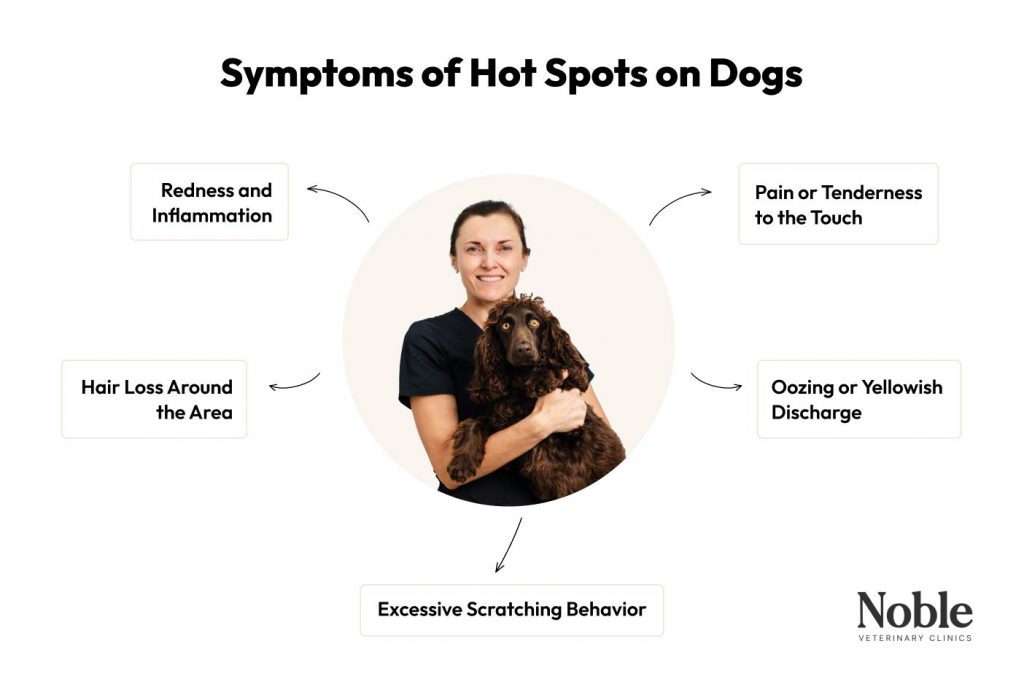Hot spots on dogs are some of the most common skin problems in canines. They are also known as acute moist dermatitis, which looks like inflamed sores on your dog’s skin. It can appear suddenly and make your pet uncomfortable.

This skin issue in dogs can be concerning for pet owners, especially those in regions with warm climates like Dubai, Singapore, and Southern China. Dogs with long coats in areas with high humidity have a greater risk of getting hot spots.
Detecting hot spots on dogs early allows your vet to treat them immediately and prevent the condition from worsening. In this guide, you will learn how to identify hot spots and how veterinarians handle this skin problem.
What Are Hot Spots on Dogs?
Hot spots on dogs, or pyotraumatic dermatitis, are caused by a bacterial infection on certain areas of the skin. They often appear as red, oozing lesions and can quickly worsen if not treated promptly.
Hot spots can usually appear on the head, hips, and legs. These sores are painful and itchy, causing a dog to scratch, lick, or bite the affected areas on the skin excessively. Because of this behavior, secondary infections often make the condition worsen.
Recognizing the Signs of Hot Spots
As pet owners, it’s important to know the symptoms of hot spots on dogs. This will help you detect the problem early so you can immediately bring your pet to the vet clinic.
- Redness and Swelling – The affected area becomes red, sore, and inflamed.
- Hair Loss – Fur surrounding the affected skin may fall out or become matted.
- Oozing or Discharge – The lesion may secrete yellowish fluid or pus.
- Constant Scratching – Dogs attempt to relieve the itching by scratching the lesions.
- Pain or Sensitivity – Touching the affected area may cause your dog discomfort.
If you notice any of these signs, you should take your dog to the pet hospital for a checkup as soon as possible to prevent the hot spots from worsening, especially when you live in an area where veterinary care is accessible, like Dubai.
Common Dog Hot Spot Causes
Hot spots on dogs can appear due to various reasons. Understanding the causes can help prevent future problems. Here are some of the common triggers of hot spots.
- Environmental allergens like pollen, mold, dust mites, and excessive heat.
- Bites from parasites, like fleas, mites, and other insects, can irritate the skin.
- Wet fur from bathing, swimming, or sweating creates an ideal environment for bacteria.
- Matted and unclean fur, especially in long-haired breeds, often leads to hot spots.
- Stress or boredom can cause dogs to lick or chew their skin excessively.
It’s also important to note that certain breeds, like Golden Retrievers, are more susceptible to developing hot spots. When living in areas with hot climates, such as Dubai, monitoring your dog regularly for symptoms is vital so they can get immediate vet care.
How to Treat Hot Spots on Dogs
Veterinarians in Dubai recommend taking your dog to the vet clinic as soon as you suspect that your pet has developed hot spots. Vets have the equipment and expertise to properly diagnose and create a treatment plan for your dog.
If your vet confirms your dog has hotspots, they will recommend and provide immediate treatment. In Dubai, vet clinics typically begin by trimming the hair around the lesion and applying an antiseptic solution to disinfect the hot spot.
Vets may prescribe medication in the form of topicals or oral antibiotics. This can include steroids or antihistamines to reduce itching and inflammation. If the underlying cause is allergies, vets may also suggest dietary changes along with medication.
For hot spots caused by parasites, vets may proceed with treatment options for effective flea management. Regular grooming may then be recommended to prevent trapping moisture and matting of their fur. Rest assured, veterinarians have the expertise and knowledge to address the root cause of your dog’s hot spots.
Prevent Hot Spots on Dogs
Prevention is always better than cure. Incorporating preventive measures for hot spots in your dog’s routine is part of being a responsible pet owner and should be a top priority to ensure your pet’s health.
Parasite control and regular grooming protect your canine companion against the causes of hot spots. Drying your pet thoroughly after any water-related activities is also good practice to prevent moisture buildup. Dubai vets also recommend mental stimulation to avoid boredom and stress-induced hot spots.
Conclusion
Mild cases of dog hot spots are often outpatient procedures and can be resolved with at-home care. However, you may need to call 24-hour vets for emergency care if the lesion has already spread to other parts of the body or when your dog shows signs of pain, fever, and weakness.
To avoid this, create a routine for your dog that involves proper hygiene and preventative measures. Taking your pet to the vet clinic for regular checkups helps ensure their health. Your vet can detect any signs of illness early and recommend treatments immediately.
Frequently Asked Questions
Why did my dog get a hot spot?
Hot spots usually develop when a dog scratches, licks, or bites an area on their skin excessively. Allergies, flea bites, bacterial infections, and other factors can also trigger this. Hot and humid climates in regions like Dubai can also make your dog’s skin more prone to irritations that can develop into spots.
What does a hotspot on a dog look like?
A hot spot on a dog typically appears as a red, inflamed, moist lesion on the skin. It may be accompanied by oozing or pus, ranging in size from small to large. The affected area may have hair loss as well.
Will a hot spot on a dog go away on its own?
While some mild hot spots might improve on their own, most cases worsen without medical intervention. They could spread throughout the dog’s body, and the lesions can become bigger, causing more health problems. Taking your dog to the vet clinic at the first sign of hot spots is always advisable.
How long does it take for a hot spot to heal?
With the right medications and treatment plan, most hot spots will show improvement within three to seven days. However, the healing time can vary depending on the severity of the hot spot and how soon treatment is started.
Are hot spots contagious?
No, hot spots are not contagious to other dogs or humans. However, the underlying causes, like flea infestations or bacterial infections, can be transmitted. It’s vital to address these issues immediately so other dogs can also be safe.
















Add Your Comment